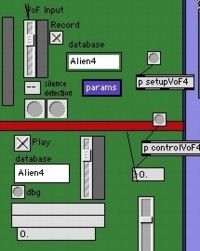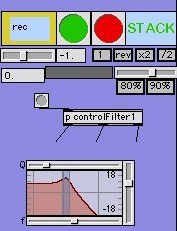Sculptures
The alien sculptures are made of urethane foam over a core of pvc or
abs pipe, with various bits of hardware embedded. For the large
PAliens, the heads were constructed in their own custom speaker
boxes, with connections to the abs spine, and the subwoofer bellies
were bolted to the spine before being foamed. The foam is either the
spray-can foam or the two-part catalytic foam, which is mixed and then
poured into plastic wrap loosely formed around their "skeletons." Two
of the aliens have heads constructed by spraying urethane foam around
an enclosed speaker, leaving a PVC joint exposed to connect the head.


 Sound System
Sound System
The amp that drives them is a 4 channel car stereo amplifier built into a pink suitcase and powered by a wheelchair battery. The suitcase has 1/4" jacks and a toggle switch built into it. The first two PAliens also had a small electronic circuit installed that "listened" to what it was saying, and flashed a blue LED light in time to the amplitude of the sounds.
The sound processing part of the system has evolved over time. In the first installation, two aliens were talking using a pair of loopers (a Boomerang, and a Line 6 delay modeler) and a reverb unit. The boomerang would play back audio that was sent to it backwards, up to two minutes later, and the line 6 looper would play what it heard in a continuous 19 second loop that built up layers of sound each time through.


 That system evolved over time using my Yellow Box performance system,
which I also used to run my band Mixtape from Mars. It contained a
full mixer, several loopers, vocal processors and reverb units, and
was built into a circus-yellow box that fit on a cart. The whole
system, including amplification, could be run on battery power
(e.g. out in the desert), or plugged into the wall.
That system evolved over time using my Yellow Box performance system,
which I also used to run my band Mixtape from Mars. It contained a
full mixer, several loopers, vocal processors and reverb units, and
was built into a circus-yellow box that fit on a cart. The whole
system, including amplification, could be run on battery power
(e.g. out in the desert), or plugged into the wall.
 The next step was to move the sound processing into software. Using
MAX/MSP, I built software modules that would emulate the various
processors in the Yellow Box. Then I strung them together, hooking the
modules up to independent inputs for the microphones, and the results
of the processing to outputs to send to the amps. The system can drive
up to 5 aliens, each on its own channel of processing, though it can
be customized for more or fewer.
The next step was to move the sound processing into software. Using
MAX/MSP, I built software modules that would emulate the various
processors in the Yellow Box. Then I strung them together, hooking the
modules up to independent inputs for the microphones, and the results
of the processing to outputs to send to the amps. The system can drive
up to 5 aliens, each on its own channel of processing, though it can
be customized for more or fewer.
The processing modules that are currently available are: looper,
backwards looper, reverb, echo/delay, pitch shifting, continuously
sweepable filter.
To top it off, I incorporates the sound module from the Voice of Fire system, so that an alien could "choose" to store data from its microphone in a sound snippet database, and then play random snippets back later, though a series of processing modules.

Where to go from Here
Given that the system now runs on software, there are two directions I
would like to take the system. 1. Write sound processors that
incorporate input from more than one sound source, combining the
sounds by some kind of convolution, or letting characteristics of one
sound source modify parameters in the other. 2. Audience
interaction/control. I would like to place control units around the
installation with knobs, buttons, or dials that modify the sound
processing in some way, though what they do to the processing will not
be labeled. The curious will find out anyways.





